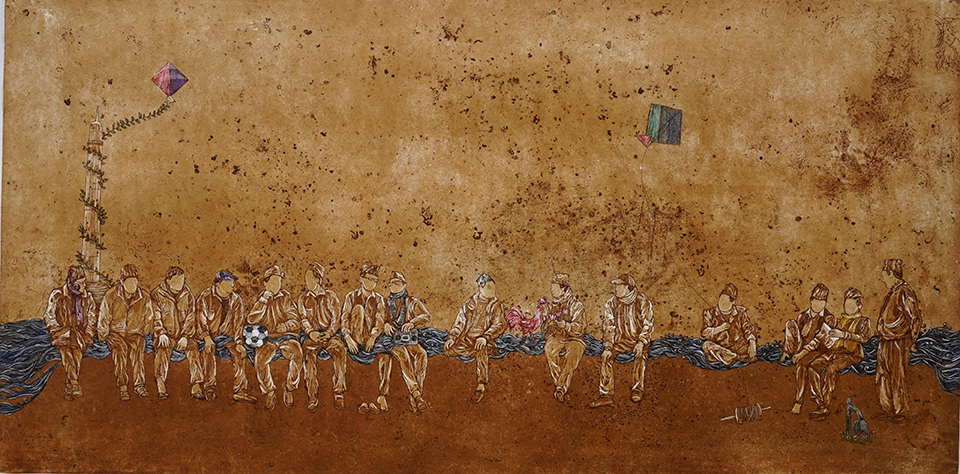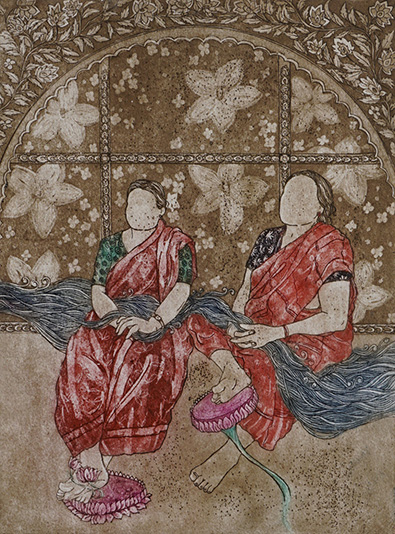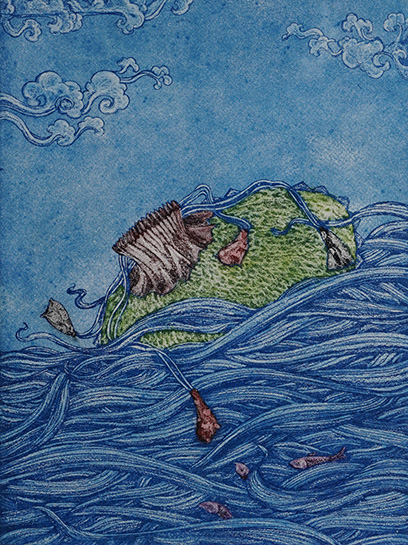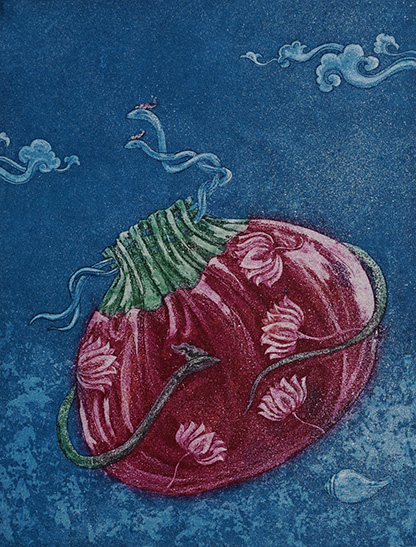Saurganga Darshandhari
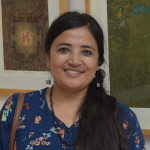
Saurganga Darshandhari uses decorative ornamentation of traditional Nepali paintings and recycles the icons and images of Hindu deities. In the same manner, the structure of Buddhist and Hindu mandalas are reformulated in modern form. She recreates the complex geometric structure using circles and squares. The religious scriptures appear here and there bringing together the visual images and verbal texts. The images of the sun and the moon appear in two corners. Similarly the pagoda temples are recurrent. The border of the circle resembles lotus petals. The structure is formed in such a way that the viewer’s attention is led toward centre, where one is supposed to coincide with the principal deity.
Saurganga Darshandhari uses decorative ornamentation of traditional Nepali paintings and recycles the icons and images of Hindu deities. In the same manner, the structure of Buddhist and Hindu mandalas are reformulated in modern form. She recreates the complex geometric structure using circles and squares. The religious scriptures appear here and there bringing together the visual images and verbal texts. The images of the sun and the moon appear in two corners. Similarly the pagoda temples are recurrent. The border of the circle resembles lotus petals. The structure is formed in such a way that the viewer’s attention is led toward centre, where one is supposed to coincide with the principal deity.
Another feature of tradition integrated in her print works is anthropomorphism. The fish and snakes appear in human form or the hybrid form of human and animals. In like manner, the anthropomorphic forms appear magical and mystical. The mother goddesses are depicted with many hands. Both the human and divine characters with round and sinuous limbs exist in perpetual youth.
Mother goddess is her recurrent image. She also depicts the veiled Muslim women implying the suppression and domination. Some of her female figures are commodified. The various agents of patriarchy turning the women apart are exploiting as the things to be consumed. Perceiving such scenario, the women feel awe- stroke and anxiety-ridden. No man looks her as whole entity, but only adores the sensuous parts. The concept of emancipation of women is the undercurrent in her works. As a self defense, the artist projects ahead the image of mother goddess, the symbol of power and fertility.
Saurganga captures unusual objects and stories from her surrounding that give inquisitive feeling to the viewers. Her works attempt to strike a balance between existence and non-existence of life, and past and present while dealing about the women of her time. Despite the use of mute colours, her prints are able to speak clearly and quietly what she has to say. Life, growth, fluidity and rhythm are presented in the images of banyan branches and roots. In addition to the use of subject matters and contents of early arts like sculpture and architecture, her works constantly refer to nature as well. Not only the etching, Saurganga expresses her feeling through installation as well. Sometimes she associates women with the cow, which is worshipped and prayed as goddess but tied and beaten as beast. One of her significant feature is the use of minimum material for the sake of clarity and simplicity.
Saurganga Darshandhari is a visual artist and printmaker based in Kathmandu. She holds a Bachelor’s degree in Fine Arts from Tribhuvan University and Master’s degree in printmaking from University of Development Alternative 2009, Dhaka, Bangladesh. Currently she is enroll in MPhils PhD in fine arts from Tribhuvan University. She has shown four solo shows ‘Printmaking Feelings’ 2010 at Kathmandu Contemporary Art Center and ‘Stories’ 2019 at Siddartha Art Gallery, “Kholo 2.0 a cycle of life” Vangogh Gallery, Patan and “The echo of lines” 2022 at Dalai La art space. She has actively showing her artworks since 2001 in Nepal, Bangladesh, India, China, South Korea , Poland, Argentina, United State Of America (World Bank, Washington DC ), Germany, Australia, Finland and Sri Lanka and has participated in artist residencies in Sri Lanka, Bangladesh, South Korea, India and home land. She has also taken part in the Kathmandu International art Festival 2009, 2012. She has participated twice in 13th and 15th Asian Art Biennale at Bangladesh and 1st Printmaking Biennale, India, 19th and 22nd Nippon International Performance Art Festival in Japan 2013 and 2017, also participated in Imago Mundi art project. She has participated in Kathmandu Triennial 2017, Tokyo International Mini Print Triennial 2018 Japan and she also participated in the International Print Exchange Program (IPEP) India and in the Now/There exhibition at the Latitude 28 Gallery, India. Recently in 2020 she had participated in online international Monsoon printmaking exhibition and more.
She has won several awards and was felicitated with first prize from red cross society 2001, receive second prize in inter college art competition 2003 and in same year she receive Sita Shree Award from Pant Society, best media award from University of Development Alternative, Dhaka, Bangladesh 2008. Some of the noteworthy felicitations and awards that she received are Basanta Women’s exhibition National Academy of fine Art 2012, National Regional Award Nepal Academy of Fine Art 2014. She was awarded from Australian Himalayan Art Foundation Award 2014, youth award 2016, awarded with Desh Bhakta Ganatantric, Shakti Award 2017 and received National regional award from Minister of culture, tourism and civil aviation Nepal government 2018.
She is the Founder of Bindu Space for Artists, General member of Sirjana College of Fine Arts and Vice- President of Printmaking Nepal, through which she has conceptualized and coordinated various art events. Amongst various events that she coordinated such as printmaking workshops, performance workshops etc; the latest and significant are the art projects in the earthquake hit areas in Nepal. Through her art organization she initiated art camps for children and other art projects helping the earthquake victims to recover from the trauma caused by the earthquake that hit Nepal in 2015. Furthermore, her organization Bindu co-organized artists’ residency and exhibition with Siddhartha Art Gallery in support of the artists who lost their homes in the earthquake.
She teaches printmaking at Lalitkala Campus and Sirjana College of Fine Arts.
